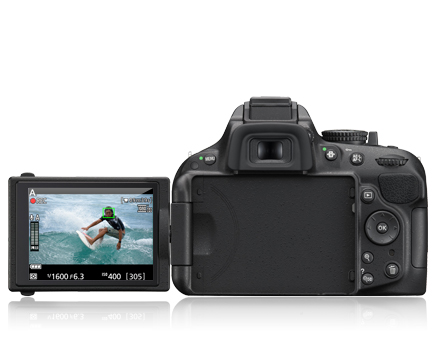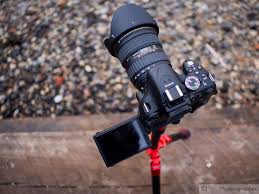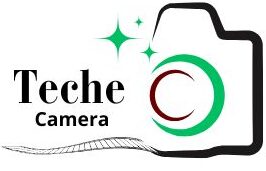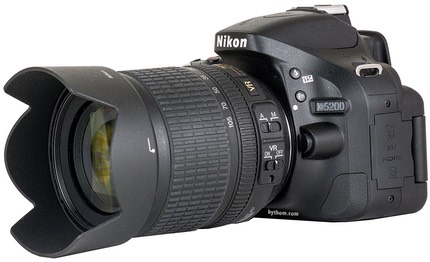The Nikon D5200 DSLR camera remains a reliable option for photography beginners and enthusiasts, even years after its launch. With a 24.1MP sensor, articulating screen, and a 39-point autofocus system, it bridges the gap between entry-level and mid-tier DSLRs.
In this detailed review, we’ll explore everything about the Nikon D5200 camera, from performance and image quality to real-world handling and lens compatibility, so you can decide if it’s still worth buying in 2025.
Overview: What Is the Nikon D5200?
Released in late 2012, the Nikon D5200 is part of Nikon’s D5000 series. It introduced several upgrades over the D5100, including a 24.1MP Toshiba APS-C sensor and a more advanced 39-point autofocus system borrowed from the higher-end D7000.
This camera was designed to offer better performance and creative control to intermediate users while still being accessible for beginners. It retains the signature fully-articulated LCD screen that makes it ideal for video recording, selfies, and shooting from tricky angles.
Despite its age, the D5200 remains popular among those looking for a DSLR with flexible shooting options, clean image quality, and an affordable price on the used market. Its combination of manual controls, decent video quality, and high-resolution stills makes it a great choice for hobbyists, students, and anyone stepping up from entry-level models.
Key Specifications of Nikon D5200
| Feature | Specification |
| Sensor | 24.1MP APS-C CMOS (Toshiba) |
| Image Processor | EXPEED 3 |
| Autofocus System | 39 points (9 cross-type) |
| ISO Range | 100–6400 (expandable to 25,600) |
| Video | Full HD 1080p at 60i/50i |
| LCD | 3-inch Vari-Angle, 921k-dot |
| Viewfinder | Optical (95% coverage) |
| Battery Life | Approx. 500 shots (EN-EL14 battery) |
| Storage | SD/SDHC/SDXC cards |
| Connectivity | Optional Wi-Fi (WU-1a) and GPS (GP-1) |
Design and Handling
The Nikon D5200 features a lightweight polycarbonate body that feels durable yet compact in hand. It weighs around 555 grams (with battery and memory card), making it portable and convenient for travel or all-day shoots. The deep grip ensures a secure hold, even for users with larger hands.

Its standout feature, a 3-inch fully articulated LCD screen, rotates freely, making it perfect for shooting at high or low angles, as well as vlogging or self-portraits. While the screen isn’t a touchscreen, it’s crisp and bright with 921,000 dots of resolution, offering clear visibility even in daylight.
The button layout is clean and designed for beginners, with a mode dial and quick-access buttons for frequently used settings. However, more experienced users might find the lack of direct buttons for ISO, metering, and white balance limiting, especially in fast-paced shooting scenarios.
Highlights:
- Fully rotating LCD screen for flexible shooting angles
- Compact grip, suitable for travel or handheld video
- Menu system is beginner-friendly and easy to navigate
Drawbacks:
- No touchscreen functionality, limiting navigation speed
- Lacks weather sealing, making it less ideal for rugged outdoor conditions
- Limited external controls compared to higher-end DSLRs
For users transitioning from smartphones or compact cameras, the D5200 feels familiar and approachable. However, photographers accustomed to advanced manual control layouts may find it slightly restrictive.
Image Quality and Sensor Performance
The Nikon D5200 is equipped with a 24.1MP APS-C CMOS sensor developed by Toshiba, a departure from Nikon’s usual use of Sony sensors. This sensor captures high levels of detail, making it suitable for large prints and aggressive cropping in post-processing.
The EXPEED 3 image processor helps deliver vibrant JPEGs with natural skin tones, accurate white balance, and minimal lag in regular operations.
Color and Dynamic Range:
- Color reproduction is punchy but realistic, great for portraits and landscapes
- Dynamic range is impressive, especially when shooting in RAW
- Highlight and shadow detail can be recovered effectively in post-processing
Low Light Performance:
- Produces clean and usable images up to ISO 1600 without noticeable degradation
- ISO 3200 and 6400 are acceptable for web use but show visible grain
- RAW shooters can push shadows and reduce noise using post-editing tools
The only notable flaw in image quality is a potential for banding noise in deep shadows. This becomes visible when severely underexposed images are brightened in editing, but doesn’t affect standard exposures.
Banding Issue:
- Pattern noise may appear in dark areas when pushed several stops in post
- Not noticeable in well-exposed images or standard editing workflows
- Tools like Topaz DeNoise or Lightroom masking can minimize this effect
Despite this, overall image quality from the D5200 is excellent for its class, especially for beginners and casual photographers aiming for DSLR-level sharpness and depth.
Autofocus and Shooting Performance
The D5200 borrows its autofocus system from the prosumer Nikon D7000, offering 39 autofocus points, including 9 cross-type sensors at the center for improved accuracy. This setup is rare in mid-range DSLRs and helps with subject tracking and composition flexibility.
The AF system performs well in well-lit environments and is effective at tracking moving subjects like pets, athletes, or children. The center points are more reliable than the outer ones, especially in low-light or backlit scenes.
Strengths:
- Quick and accurate autofocus in daylight conditions
- Capable of tracking fast-moving subjects with decent precision
- Works reliably with AF-S and AF-P lenses for still photography
- Great autofocus performance for entry and mid-level DSLR standards
Weaknesses:
- Live View autofocus is contrast-detection only, making it slow and jerky
- No AF Fine Tune function, so you can’t micro-adjust lens calibration
- Screw-drive lenses (like older AF or AF-D Nikkor lenses) won’t autofocus
For sports, wildlife, and general shooting, the D5200 delivers solid autofocus results. However, for video shooting or using Live View often, the focus system may feel outdated compared to newer mirrorless cameras.
Its continuous shooting mode delivers 5 frames per second, which is sufficient for casual action or burst photography but may fall short for professional sports work.
Video Capabilities of the Nikon D5200
| Feature | Details |
| Maximum Resolution | Full HD 1080p (1920×1080) at 60i / 50i / 30p / 25p / 24p |
| Audio | Built-in stereo microphone + external mic input |
| Video Format | H.264 / MPEG-4 AVC format |
| Autofocus During Video | Contrast-detect AF (slow and not ideal for moving subjects) |
| Manual Controls | Limited manual exposure control during recording |
| Rolling Shutter | Noticeable during fast pans or movement |
| Screen for Monitoring | 3-inch vari-angle LCD (non-touch) |
| HDMI Output | Yes, with clean output (great for external recorders) |
Pros and Cons of Nikon D5200 Video
| Pros | Cons |
| Full HD 1080p recording with good detail | No 4K video support |
| External microphone input for better audio | Rolling shutter visible during fast motion |
| Clean HDMI output for external recorders | Manual focus preferred due to slow contrast AF |
| Rotating screen helps with vlogging and creative angles | Limited manual video controls |
Battery Life and Buffer Performance
The Nikon D5200 uses the EN-EL14 rechargeable lithium-ion battery, which delivers approximately 500 shots per charge according to CIPA standards. However, real-world results may vary depending on usage, especially when using features like Live View, the articulating LCD, or video recording.
For regular photography, a single battery can last a full day of casual shooting. But for long events, time-lapse work, or video recording sessions, carrying at least one spare battery is highly recommended. Power-saving habits such as dimming the LCD or turning off image review can also help extend battery life.

Buffer Details:
| Image Format | Shots Before Buffer Fills |
| RAW (14-bit NEF) | Approx. 6–8 shots |
| JPEG Fine Large | Approx. 35 shots |
| JPEG Normal Large | Higher buffer capacity (~100 shots) |
The buffer is sufficient for short bursts but can fill quickly when shooting RAW, especially in continuous mode. Once full, you’ll need to wait for the camera to write data to the memory card before shooting resumes.
Recommendations:
- Use UHS-I compatible SD cards for faster write speeds
- Lower image quality settings if continuous shooting is a priority
- Avoid slow memory cards, as they drastically increase buffer clearing time
If you’re into action, wildlife, or sports photography, the buffer and card speed are critical. Shooting RAW at 5 fps will fill the buffer in less than 2 seconds, making it essential to use high-speed cards and plan shots accordingly.
Lens Compatibility
The Nikon D5200 uses the Nikon F-mount (DX format), which supports a wide range of Nikon and third-party lenses. However, it does not have an internal autofocus motor, which means that autofocus is only supported with lenses that have built-in motors.
This limitation affects compatibility with older Nikon lenses that rely on camera body motors for AF.
Autofocus-Compatible Lenses:
- Nikon AF-S and AF-P lenses (contain built-in Silent Wave or Pulse motors)
- Sigma HSM lenses (Hyper Sonic Motor)
- Tamron USD lenses (Ultrasonic Silent Drive)
- Tokina lenses with built-in AF motors
These lenses will autofocus normally and are the best options for Nikon D5200 users.
Manual Focus Only (No Autofocus):
- Nikon AF and AF-D lenses (screw-drive, require body motor)
- Older manual focus lenses like AI, AI-S, and pre-AI
- Classic third-party lenses without internal AF motors
While these lenses can still be mounted and used, focus must be done manually, and exposure metering may be limited depending on the lens.
Additional Lens Notes:
- DX lenses are designed specifically for APS-C sensors like the D5200, offering ideal size and focal range.
- FX lenses (full-frame) can be used but will provide a 1.5x crop factor. For example, a 50mm FX lens behaves like a 75mm lens on the D5200.
- Some third-party lenses may require firmware updates for optimal performance or might have limited compatibility.
Recommended Lenses for D5200:
| Lens Name | Use Case |
| Nikon 35mm f/1.8G DX | Street, portraits, general use |
| Nikon 18-140mm f/3.5-5.6G VR | All-in-one travel zoom |
| Sigma 17-50mm f/2.8 OS HSM | Low-light, events, sharpness |
| Tamron 70-300mm f/4-5.6 Di VC USD | Budget-friendly telephoto |
| Nikon 50mm f/1.8G | Portraits, shallow depth of field |
For the best experience, stick to AF-S or AF-P lenses, as they fully support autofocus and metering features on the D5200.
Nikon D5200 vs D5100 vs D7100
| Feature | D5100 | D5200 | D7100 |
| Sensor | 16.2MP Sony | 24.1MP Toshiba | 24.1MP Sony |
| Autofocus Points | 11 | 39 | 51 |
| ISO Range | 100–6400 | 100–6400 | 100–6400 |
| AF Fine Tune | No | No | Yes |
| Weather Sealing | No | No | Yes |
| Video Frame Rate | 1080p 30fps | 1080p 60i | 1080p 60i |
Pros and Cons Summary
Pros
- High-resolution 24.1MP sensor delivers sharp, detailed images ideal for printing or cropping
- Reliable 39-point autofocus system, including 9 cross-type sensors for better subject tracking
- Fully articulated 3-inch LCD screen allows for flexible shooting angles, selfies, and vlogging
- Excellent color reproduction and dynamic range for a DSLR in its price class
- External microphone input improves audio quality for video creators
- Compact and lightweight DSLR body, easy to carry for travel or all-day shooting
- Compatible with a wide range of AF-S, AF-P, Sigma HSM, and Tamron USD lenses
- Good battery life for everyday use (up to 500 shots per charge)
- Affordable in the used market, offering solid performance for budget-conscious photographers
- Customizable Fn button allows quick access to commonly used settings
Cons:
- No touchscreen, which makes menu navigation slower compared to modern DSLRs or mirrorless cameras
- Limited buffer — only 6–8 RAW images in burst mode before slowdown
- No 4K video recording, which is now standard on newer cameras
- Autofocus during Live View and video is slow, making it unsuitable for fast-moving subjects
- Noticeable banding in deep shadows when pushing exposure in post-processing
- No in-body image stabilization (IBIS), requiring stabilized lenses for steady video
- No autofocus support for screw-drive AF lenses, limiting legacy lens compatibility
- Lack of weather sealing, making it less reliable in harsh or wet environments
- No AF micro-adjustment (AF Fine Tune), so lens focusing errors cannot be calibrated
- Menus and controls can feel outdated for users accustomed to newer touch interfaces
Who Should Buy the Nikon D5200 in 2025?
The Nikon D5200 is a good option if you are:
- Upgrading from an entry-level DSLR (D3100, D5000, etc.)
- A beginner or photography student
- A casual photographer who values sharp images and basic manual control
- A budget-conscious buyer looking for DSLR features without spending too much
Avoid it if you require fast live view autofocus, 4K video, or full lens compatibility with older Nikon glass.
Recommended Lenses for Nikon D5200
- Nikon 35mm f/1.8G DX – Versatile, sharp, and lightweight prime
- Nikon 50mm f/1.8G – Ideal for portraits with creamy background blur
- Sigma 17-50mm f/2.8 OS HSM – Sharp and fast for general-purpose use
- Nikon 18-140mm f/3.5-5.6 VR – Great walk-around lens
- Tamron 70-300mm f/4-5.6 Di VC USD – Budget-friendly telephoto
Frequently Asked Questions (FAQs)
1. Does the Nikon D5200 have built-in Wi-Fi?
No, but it supports the optional WU-1a wireless adapter.
2. Can the D5200 shoot 4K videos?
No. It supports Full HD 1080p only.
3. Can I use older Nikon AF-D lenses with autofocus?
No, those lenses will work but only with manual focus.
4. Is the Nikon D5200 good for low-light photography?
Yes, up to ISO 1600 is usable. Higher ISO settings show noticeable noise.
5. How much is the Nikon D5200 worth in 2025?
Used prices range from $200 to $300, depending on condition and lens bundle.
Final Verdict: Is the Nikon D5200 Still a Good Buy?
In 2025, the Nikon D5200 remains a capable DSLR with impressive image quality and solid features for its price. While it lacks some modern amenities like 4K video and touchscreen, it continues to deliver excellent value for photographers who want a reliable, sharp-shooting camera without spending a fortune.
Whether you’re just starting in photography or looking for a backup camera, the camera D5200 Nikon is a smart choice, as long as you’re aware of its limitations and pair it with the right lenses.

